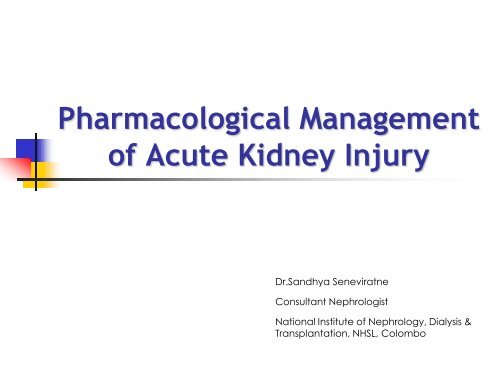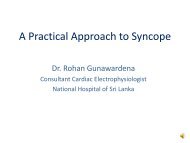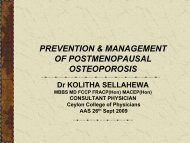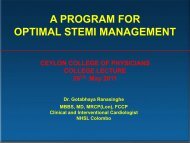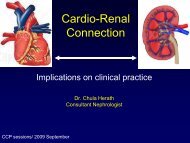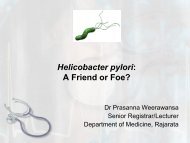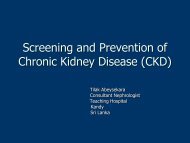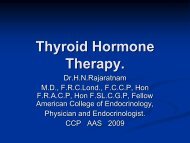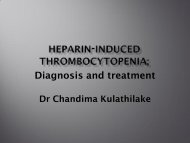Pharmacological Management of Acute Kidney Injury
Pharmacological Management of Acute Kidney Injury
Pharmacological Management of Acute Kidney Injury
You also want an ePaper? Increase the reach of your titles
YUMPU automatically turns print PDFs into web optimized ePapers that Google loves.
<strong>Pharmacological</strong> <strong>Management</strong><br />
<strong>of</strong> <strong>Acute</strong> <strong>Kidney</strong> <strong>Injury</strong><br />
Dr.Sandhya Seneviratne<br />
Consultant Nephrologist<br />
National Institute <strong>of</strong> Nephrology, Dialysis &<br />
Transplantation, NHSL, Colombo
Nephrology telephone referral<br />
A 44 year old man was admitted with a 5<br />
day history <strong>of</strong> abdominal pain and<br />
vomiting. BP 67/43, pulse 132, Temp 39.1.<br />
Urea 47mmol/l, sodium 132 mmol/l,<br />
potassium 6.3 mmol/l, creatinine 675<br />
umol/l.
RESUSCITATE
Be quick, do refer<br />
• Treatment, investigation and assessment need<br />
to happen simultaneously<br />
• Investigations need to be carried out within a<br />
matter <strong>of</strong> minutes<br />
• One non-dialytic intervention has been shown<br />
to be successful in improving the morbidity and<br />
mortality <strong>of</strong> ARF<br />
• Early referral is advisable in cases <strong>of</strong> pre-renal<br />
failure not responding to fluids, intrinsic<br />
• Mandatory in RPGN
It’s costly!<br />
• Only modest improvements in mortality over the last 25<br />
years or so<br />
• Therefore pathophysiology and therapy are being<br />
constantly reviewed.
Defined<br />
• Defined as an abrupt sustained decline in<br />
glomerular filtration rate causing retention <strong>of</strong><br />
nitrogenous waste products<br />
• Usually accompanied by a rise in serum<br />
creatinine and urea<br />
• Usually associated with oliguria and loss <strong>of</strong><br />
normal water and solute homeostasis<br />
• And is potentially reversible
Uraemia<br />
• Is generally used to describe the ill-effects <strong>of</strong><br />
renal failure that we cannot yet explain<br />
• ……..the ill-effects that would remain if the<br />
extra-cellular volume and the inorganic ion<br />
concentrations were kept normal and the<br />
known renal synthetic products were replaced<br />
in patients without kidneys
Diagnosis <strong>of</strong> ARF<br />
• Clinically overt ARF poses no problem<br />
• Typically diagnosed by observing a rising urea<br />
and creatinine with a declining urine output<br />
over a period <strong>of</strong> several days<br />
• Unfortunately- creatinine and creatinine<br />
clearance are sub-optimal indicators <strong>of</strong> renal<br />
function, and <strong>of</strong>ten delay the diagnosis <strong>of</strong> ARF<br />
• Need a marker <strong>of</strong> renal failure/quick method<br />
<strong>of</strong> measuring function.
GFR and creatinine
Causes <strong>of</strong> ARF<br />
• Pre-renal, renal and post-renal<br />
• 50% - ischaemic<br />
• 35% - nephrotoxic<br />
• 15% - intrinsic<br />
• 50% <strong>of</strong> hospital acquired ARF is multifactorial<br />
• E.g.. Sepsis+aminoglycosides,<br />
Radiocontrast + ACEI.
Principles <strong>of</strong> <strong>Management</strong><br />
1. Making the patient safe,<br />
2. treating life-threatening metabolic disturbances,<br />
irrespective <strong>of</strong> the cause<br />
3. Non-dialytic treatment measures – drugs, nutrition,<br />
fluid replacement<br />
4. Initiating renal replacement therapy (RRT) when<br />
appropriate<br />
5. Investigating and treating the primary aetiology –<br />
pre-renal, renal and post-renal
Clinical Definitions<br />
<strong>Acute</strong> v Chronic Renal<br />
Failure<br />
Reversible Irreversible<br />
v<br />
Sudden Insidious onset<br />
v
<strong>Acute</strong> Renal Failure<br />
• Abrupt decline <strong>of</strong> previously normal renal<br />
function causing retention <strong>of</strong> nitrogenous waste<br />
products<br />
• POTENTIALLY REVERSIBLE
<strong>Acute</strong> on Chronic Renal Failure<br />
• Abrupt potentially reversible decline <strong>of</strong> renal<br />
function in a patient with pre-existing renal impairment
Serum Creatinine = 150 umol/l<br />
Weight 125 kg = 125 kg<br />
Creatinine clearance = 118 ml/min<br />
Serum Creatinine = 150 umol/l<br />
Weight = 25 kg<br />
Creatinine clearance = 20 ml/min
• What does he look like ?
Is he sick?
Or feeling well?
Treating Life-threatening Metabolic<br />
Conditions<br />
• Hyperkalaemia<br />
• Fluid overload<br />
• Acidosis<br />
• Severe uraemia<br />
• Bleeding diathesis.
Treatment <strong>of</strong> Hyperkalaemia<br />
? Haemolysed<br />
? Supplements<br />
? drugs<br />
Start low K +<br />
diet<br />
Hyperkalaemia<br />
[K + ] > 6.5 mmol/L<br />
±ECG changes<br />
Dialyse<br />
10% Ca gluconate 10ml IV<br />
Any other indication<br />
for dialysis?<br />
10u s.insulin in 50ml<br />
50% dextrose IV over<br />
10mins<br />
?NaHCO 3 if [HCO 3 ] < 20<br />
mmol/L 300-600 ml<br />
Persistent life-threatening<br />
[K + ]<br />
Recheck [K + ] 6 hrly<br />
[K + ] but not lifethreatening<br />
ion exchange resin +<br />
lactulose + s.insulin/dextrose
A 63 year old lady presents with<br />
prostration, one week after a change in<br />
medication for CCF. BP is 70 systolic,<br />
she has a bradycardia <strong>of</strong> 34 bpm and<br />
moderate oedema.<br />
Medication is frusemide 120 mg daily,<br />
spironolactone 25 mg daily, ramipril 10<br />
mg daily, carvedilol 3.125 mg bd,<br />
hydralazine 50 mg bd, isosorbide<br />
mononitrate SR 30 mg daily.
……and a serum potassium concentration <strong>of</strong> 9.6<br />
mmol/l, pH 7.01, bicarbonate 7 mmol/l, creatinine 494<br />
umol/l.
Treatment <strong>of</strong> Fluid Overload<br />
• Avoid injudicious fluid replacement<br />
• the fluid “challenge”, CVP lines especially in oedematous<br />
patients with suspected intra-vascular fluid depletion, use<br />
the correct fluid<br />
• Nitrates<br />
• Diuretics<br />
• Oxygen<br />
• Morphine<br />
• Haem<strong>of</strong>iltration (in ICU)<br />
• Venesection<br />
• Dialysis.
Treatment <strong>of</strong> Pulmonary<br />
Oedema in ARF<br />
In oligo-anuric patient, nonresponsive<br />
to diuretics<br />
Emergency IHD if available on site<br />
and normal or high BP<br />
Otherwise CVVH in ITU/HDU
Treatment <strong>of</strong> Acidosis<br />
• NaHCO 3 1.26% IV /oral <strong>of</strong> bicarbonate
Pr<strong>of</strong>ound acidosis in the context <strong>of</strong><br />
oligo-anuria requires urgent<br />
haemodialysis unless the patient is<br />
dehydrated
Acetate vs. Bicarbonate<br />
dialysis<br />
Liver failure<br />
Sepsis<br />
Severly ill/critically ill<br />
pregnancy
Correction <strong>of</strong> Hypovolaemia<br />
• Type <strong>of</strong> replacement solution depends on<br />
source <strong>of</strong> fluid loss<br />
• Bleeding, haemodynamically unstable or HCt<br />
very low → packed red cells<br />
• Otherwise isotonic saline for plasma losses<br />
• (use <strong>of</strong> starch, gelatin, colloids independent<br />
risk factor for development <strong>of</strong> AKI)<br />
• Urinary and GI losses are hypotonic therefore<br />
initial replacement with 0.45% saline
Pre - renal<br />
A Comparison <strong>of</strong> Albumin and Saline for Fluid<br />
Resuscitation in the Intensive Care Unit (SAFE Study)<br />
methods<br />
Randomly assigned patients who had been admitted to the ICU to receive either 4 percent<br />
albumin or normal saline for intravascular-fluid resuscitation during a period <strong>of</strong> 28 days. The<br />
primary outcome measure was death from any cause during the 28-day period after<br />
randomization.<br />
conclusions<br />
In patients in the ICU, use <strong>of</strong> either 4 percent albumin or normal saline for fluid resuscitation<br />
results in similar outcomes at 28 days.
Treatment <strong>of</strong> Uraemia<br />
• Look for the complications<br />
• encephalopathy<br />
• pericarditis<br />
• pericardial effusion<br />
• bleeding diathesis<br />
• Pericardiocentesis<br />
• Dialysis<br />
• if HD initially short dialysis to prevent precipitating cerebral<br />
oedema
Bleeding Diathesis<br />
• Haematocrit to at least 30%<br />
• Cryoprecipitate<br />
• DDAVP<br />
• Oestrogen<br />
• Discontinue anti-platelet drugs<br />
• H2-receptor blockers<br />
• Dialysis
Non-dialytic supportive measures<br />
• A brief review <strong>of</strong> the therapeutic options, and<br />
a look at recent developments
Prevention <strong>of</strong> radiocontrast-induced nephropathy. Asif A,<br />
Epstein M. Am J <strong>Kidney</strong> Dis. 2004 Jul;44(1):12-24<br />
Radiocontrast is a common cause <strong>of</strong> hospitalacquired<br />
ARF mainly in patients with preexisting<br />
renal failure<br />
Saline hydration is the sole proven effective<br />
protection<br />
The benefits <strong>of</strong> the antioxidant N-acetylcysteine, isoosmolar<br />
contrast agents, fenoldopam (dopamine-1 [DA-<br />
1] receptor agonist), hemodialysis, and hem<strong>of</strong>iltration,<br />
are less certain.
Dopamine<br />
Critical Care Medicine:<br />
August 2001 - Volume 29 - Issue 8 - pp 1526-1531<br />
Clinical Investigations<br />
Use <strong>of</strong> dopamine in acute renal failure: A metaanalysis<br />
(<strong>of</strong> 58 studies)<br />
Conclusions: The use <strong>of</strong> low-dose dopamine for<br />
the treatment or prevention <strong>of</strong> acute renal failure<br />
cannot be justified on the basis <strong>of</strong> available<br />
evidence and should be eliminated from routine<br />
clinical use
Fenoldopam<br />
Crit Care Med. 2005 Nov;33(11):2451-6.<br />
Prophylactic fenoldopam for renal protection in sepsis: a<br />
randomized, double-blind, placebo-controlled pilot trial.<br />
Fenoldopam, a dopamine-1 receptor agonist, increases renal blood<br />
flow and may, therefore, reduce the risk <strong>of</strong> acute renal failure in<br />
such patients. 300 septic patients fenoldopam vs placebo<br />
No significant difference in incidence <strong>of</strong> severe<br />
ARF but smaller rises in creatinine in the<br />
fenoldopam group
Efficacy <strong>of</strong> Fenoldopam in Reducing the Need for<br />
Renal Replacement Therapy After Cardiac<br />
Surgery. A Randomized Controlled Study.<br />
On-going
Atrial Natriuretic Peptide for <strong>Management</strong> <strong>of</strong> <strong>Acute</strong> <strong>Kidney</strong> <strong>Injury</strong>:<br />
A Systematic Review and Meta-analysis<br />
Clin J Am Soc Nephrol 4: 261-272, 2009<br />
© 2009 American Society <strong>of</strong> Nephrology<br />
• Results: Nineteen RCTs (11 prevention, 8 treatment) involving 1861<br />
participants were included. Pooled analysis <strong>of</strong> prevention trials<br />
showed a trend toward reduction in renal replacement therapy in<br />
the ANP group (OR = 0.45, 95% CI, 0.21 to 0.99) and good safety<br />
pr<strong>of</strong>ile, but no improvement in mortality. For the treatment <strong>of</strong><br />
established AKI, ANP, particularly in high doses, was associated with<br />
a trend toward increased mortality and more adverse events.<br />
Subgroup analysis <strong>of</strong> AKI after a major surgery (14 RCTs, 817<br />
participants) showed a significant reduction in renal replacement<br />
therapy requirement in the ANP group
Vasodilators (Other)<br />
• Calcium Channel Blockers<br />
• Useful post-transplant<br />
• Given intrarenally may shorten course <strong>of</strong> ARF<br />
(malaria, tropical diseases).
Diuretics<br />
• Basis : wash away the dirt<br />
• Conclusion : Diuretics can make oliguric renal<br />
failure polyuric, and thereby easier to manage<br />
• Frusemide<br />
• Decreases work <strong>of</strong> TA<br />
• May flush away obstructing casts, decreases<br />
concentration <strong>of</strong> nephrotoxic substances<br />
• Makes patient polyuric – prognosis better<br />
• It’s ototoxic, therefore a trial only<br />
• No solid evidence that it alters natural history.
Diuretics<br />
• Mannitol<br />
•No
Growth factors<br />
• Basis : After sublethal injury the dysfunctional<br />
kidney can restore normal function and structure<br />
• Conclusion : renotrophic growth factors are a<br />
promising area for future research<br />
• Epidermal growth factor (EGF), Transforming<br />
growth factor (TGF), Insulin-like growth factor-1<br />
(IGF-1) and Hepatocyte growth factor (HGF)<br />
• Found in the kidney<br />
• High levels after injury<br />
• IGF-1 two trials – benefits patients with less severe<br />
renal injury.
Anti-inflammatory agents<br />
• Basis : The ischaemic kidney produces a<br />
number <strong>of</strong> inflammatory mediators;<br />
tubular cells participate in immune and<br />
inflammatory reactions<br />
• Conclusion :Antibodies to ICAM-1, antineutrophil<br />
agents are still at trial level
Nutrition in <strong>Acute</strong> Renal Failure<br />
• Nutrition should not be compromised to minimize<br />
azotaemia<br />
• When ARF is isolated energy requirements are probably<br />
not increased.<br />
• >15%-20% in patients on IHD<br />
• Recommendations<br />
• Calories 30kcal/kg BW/day + adjustment factors<br />
• 70% carbohydrates 30% lipids<br />
• Proteins (on dialysis) 1.1-1.2g/kg BW/day (otherwise<br />
0.8g/kg/day)<br />
• Micronutrients? Se, vitamin E<br />
• Enteral preferable<br />
• TPN if necessary.
Renal Replacement Therapy in ARF<br />
• When should dialysis be initiated?<br />
• What mode <strong>of</strong> dialysis should be used?<br />
• How much dialysis should be given?<br />
No consensus<br />
• Absolute indications<br />
• uraemic pericarditis<br />
• uraemic encephalopathy.
Renal Biopsy in ARF<br />
• Generally not indicated<br />
• Exclude pre- and post-renal by history,<br />
examination, laboratory and radiological<br />
investigation<br />
• Intrinsic renal disease other than ischaemic or<br />
toxin induced suspected<br />
• Uncertainty <strong>of</strong> diagnosis, lack <strong>of</strong> spontaneous<br />
recovery even with cessation <strong>of</strong> drug<br />
• 15,720 – nephrectomy 0.06%<br />
• Mortality – 0.1%<br />
• Take the proper precautions.
Conclusion<br />
• ARF is a medical emergency<br />
• Priority is to make patient safe<br />
• Early correct treatment <strong>of</strong> volume depletion is<br />
important<br />
• Obstruction should be excluded very early<br />
• Newer non-dialytic therapies are being evaluated<br />
• Nephrological referral improves mortality<br />
• Dialysis is complicated – it is recommended that<br />
nephrological opinion be obtained<br />
• Nutrition should not be compromised<br />
• Renal biopsy should be considered when in doubt.
Acknowledgements<br />
• To Pr<strong>of</strong>. Ken Farrington for some <strong>of</strong> the slides


